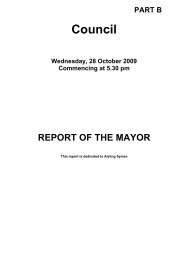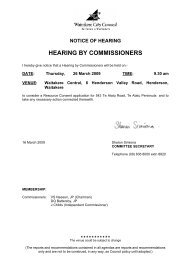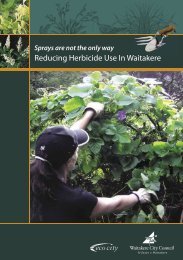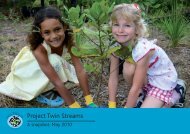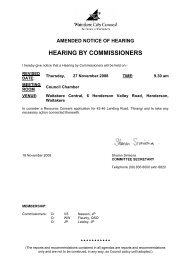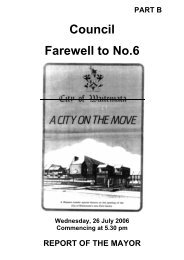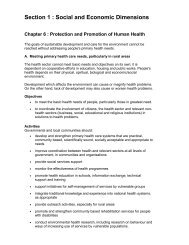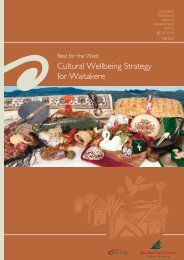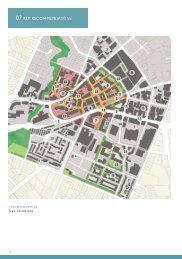Henderson Valley/Opanuku Local Area Plan ... - Auckland Council
Henderson Valley/Opanuku Local Area Plan ... - Auckland Council
Henderson Valley/Opanuku Local Area Plan ... - Auckland Council
Create successful ePaper yourself
Turn your PDF publications into a flip-book with our unique Google optimized e-Paper software.
4.3. SUBDIVISION ISSUESIn <strong>Henderson</strong> <strong>Valley</strong>/<strong>Opanuku</strong>, there are significant pressures for subdivision over and above theDistrict <strong>Plan</strong> provisions - an almost inevitable feature at a rural/ urban interface in the <strong>Auckland</strong>region. In the neighbouring areas of Oratia and Swanson, additional subdivision (andaccompanying environmental enhancement measures) has been provided for through ruralstructure planning processes. However the Structure <strong>Plan</strong> Review and more recent Swansonexperience found that the costs associated with the development of a structure plan (considerablelitigation, technical assessments, and community division) outweighed the gains (limiteddevelopment potential or environmental enhancement) of undertaking the structure planningexercise, particularly in the absence of a strategic framework under which to consider structureplanning. The additional technical work undertaken in <strong>Henderson</strong> <strong>Valley</strong>/<strong>Opanuku</strong> has indicatedthat a Structure <strong>Plan</strong> is not necessary to accommodate future growth in a sustainable manner.The <strong>Local</strong> <strong>Area</strong> <strong>Plan</strong> process has highlighted a divergence of views on subdivision (refer to the<strong>Henderson</strong> <strong>Valley</strong> Community Consultation report). On one hand members of the wider communityhas indicated a strong desire to maintain the status quo by retaining a productive rural landscapewith larger rural properties, and to avoid the structure plan route that would provide for subdivisionbeyond the ‘4 hectare rule’ of the District <strong>Plan</strong>, as they had observed it in Oratia and Swanson.However, there are also strong views from individual landowners believing that more developmentis possible and desirable, ranging from urban type development through to a staged graduation ofdensity from urban, to large lot rural as one moves through the valley and away from the urbanarea.In addition to these diverse community views, the regulatory landscape has changed considerablyover the past few years, with the passing of the Waitakere Ranges Heritage <strong>Area</strong> Act 2008(WRHAA), amendments to the <strong>Auckland</strong> Regional Policy Statement (ARPS) through <strong>Plan</strong> Change6, and the Waitakere City Operative District <strong>Plan</strong> 2003 (Waitakere District <strong>Plan</strong>) via <strong>Plan</strong> Change16, and also through the recent notification of <strong>Plan</strong> Changes 35 and 36. (see also the WaitakereRanges Foothills Background report for more detailed analysis of relevant provisions).The WRHAA is clear that the heritage area (including the Foothills) will remain a rural place, thatsubdivision must not lead to urban sprawl, in seeking to protect heritage features the area has littlecapacity to absorb further subdivision, and heritage features (as outlined later in this report) must beprotected, restored and enhanced. Provisions of the WRHHA, including the Objectives andFeatures are proposed to be inserted directly into the District <strong>Plan</strong> via proposed <strong>Plan</strong> Change 35 18 .The ARPS identifies the upper part of <strong>Henderson</strong> <strong>Valley</strong>/<strong>Opanuku</strong> as areas of Significant NaturalHeritage Value and Significant Landscape quality and sensitivity and so should be managedaccordingly. Objective 2.6.1.1.19 and Policy 2.6.17 generally, and 2.6.17.1(e)(i) and 2.6.17.3 and 4especially, indicate that the Waitakere Ranges and their associated environmental values shall beprotected from inappropriate subdivision use and development and that low density residentialdevelopment (as anticipated by structure <strong>Plan</strong>ning in the Waitakere District <strong>Plan</strong>) shall be avoidedin rural areas unless additional capacity is required. The ARPS indicates that existing District <strong>Plan</strong>provisions provide 40 years capacity in the <strong>Auckland</strong> region, and analysis elsewhere in thisdocument shows that <strong>Henderson</strong> <strong>Valley</strong>/<strong>Opanuku</strong> has over 25 years of potential at current rates oftake up.Pursuant to s 73 of the RMA and s11 of the WRHHA Act, District <strong>Plan</strong>s must “give effect to“ boththe ARPS and the purpose and objectives of the WRHAA. Waitakere District <strong>Plan</strong> Change 16“gives effect” to these higher order documents through now operative Policy 0.11 by indicating thatfurther intensive settlement will not be provided in the Waitakere Ranges 19 . As noted above18 At the time of writing <strong>Plan</strong> Change 35 further submissions have just closed, and is at a very early stage ofthe process.19 This Policy has recently been the subject of a Consent Order and is now considered Operative.Page 53 of 65



